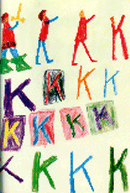 The
concept includes a general introduction, as well as: The
concept includes a general introduction, as well as:
 3.1 intellectual 3.1 intellectual
 3.2 musical-creative 3.2 musical-creative
 3.3 social
and 3.3 social
and
 3.3 physical 3.3 physical
areas (general concept overviews), and a conclusion with explanations.
The 'mainstream' of education, which commences
at elementary school age, must be constantly re-evaluated and re-organized.
All four areas are described in their primary tasks, but their application
is a process, just like the students' learning itself. Concurrently,
the teachers become
process-guides, who, through the constantly
occurring change, participate in their own improvement process.
The dissolving of traditional time-, space-, and age structures (grades,
periods, classrooms) on one hand promotes concentration, and on the
other supports the natural learning rhythm and the 'sinking in'
of learned material. 'Core-sessions' of acquisition alternate
with musical-creative 'Fantasy-sessions',
or physical education. Although specific time is set aside
for social education, it is mostly integrated with the other areas, and
also partially shifted to extramural tasks.
 Although
each child, dependent on their respective age, possesses approximately
similar degrees of physical development, their degrees of intellectual,
creative, or even social development may differ significantly.
Individual talents, whether genetically passed down, acquired from
the social environment, or parentally encouraged, become important factors
which can be supported and developed through process-guided learning.
What all children have in common, though, is their curiosity and the urge
to discover and try the new. This curiosity remains the basic
motivation for wanting to learn, to discover, invent, understand, and to
experience practical life and find a place in society. Although
each child, dependent on their respective age, possesses approximately
similar degrees of physical development, their degrees of intellectual,
creative, or even social development may differ significantly.
Individual talents, whether genetically passed down, acquired from
the social environment, or parentally encouraged, become important factors
which can be supported and developed through process-guided learning.
What all children have in common, though, is their curiosity and the urge
to discover and try the new. This curiosity remains the basic
motivation for wanting to learn, to discover, invent, understand, and to
experience practical life and find a place in society.
 3.1 Intellectual
area: 3.1 Intellectual
area:
 Which
are the basic skills children learn in elementary school? On
one hand, the classic cultural techniques, such as writing, reading, and
basic math, on the other, fundamental knowledge that allows them
to discover and understand their world, such as biology, geography,
history, etc. As mentioned before, children begin school with
certain suppositions. In order not to suffocate their interest
and curiosity, and to offer them a playful and simple intercourse with
the innovative, knowledge acquisition is arranged via the computer.
Through the use of instructional programs especially geared for
access by children, students can satisfy their exploring spirits by
clicking through the respective subject areas. They will
solve tasks in a playful manner through their curiosity and thirst
to discover. If a student is at first unable to complete a
task, the program will offer additional help, keeping frustration
to a minimum. In any event, the pupils will solve tasks either
independently, or through the help of the group and integrated older
students, which can be asked for help anytime. Which
are the basic skills children learn in elementary school? On
one hand, the classic cultural techniques, such as writing, reading, and
basic math, on the other, fundamental knowledge that allows them
to discover and understand their world, such as biology, geography,
history, etc. As mentioned before, children begin school with
certain suppositions. In order not to suffocate their interest
and curiosity, and to offer them a playful and simple intercourse with
the innovative, knowledge acquisition is arranged via the computer.
Through the use of instructional programs especially geared for
access by children, students can satisfy their exploring spirits by
clicking through the respective subject areas. They will
solve tasks in a playful manner through their curiosity and thirst
to discover. If a student is at first unable to complete a
task, the program will offer additional help, keeping frustration
to a minimum. In any event, the pupils will solve tasks either
independently, or through the help of the group and integrated older
students, which can be asked for help anytime.
In 'Core-sessions', tasks are solved in small groups (max. 6); individual
learning- and exercise sessions are also arranged. After some time,
the groups are rearranged (some reach the process-goal sooner) in the various
subjects. The pupils can then begin to tackle new goals in accord
with their own abilities and at their own pace, provided the process-goal
has been achieved and acknowledged by the process-guide.
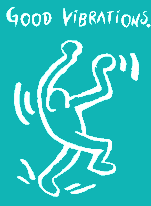 This
way even writing and reading are learned via computer programs. This
eliminates the burden of simultaneously learning content as well
as the physical process of writing itself (how do I write legibly
and spell correctly), which is a problem for many children. My concept
instead plans a reorientation: writing will be practiced on the
computer, while learning hand writing skills is transferred into
the musical-creative area, where it can be rehearsed with the appropriate
muse and artistry. The same goes for reading, which is not only
learned on the computer. This
way even writing and reading are learned via computer programs. This
eliminates the burden of simultaneously learning content as well
as the physical process of writing itself (how do I write legibly
and spell correctly), which is a problem for many children. My concept
instead plans a reorientation: writing will be practiced on the
computer, while learning hand writing skills is transferred into
the musical-creative area, where it can be rehearsed with the appropriate
muse and artistry. The same goes for reading, which is not only
learned on the computer.
Reading, as in experiencing stories, legends, fairy tales, and myths,
is a totally different perception process than the mere reading
and comprehension of facts. The appropriate program can even
offer texts in different languages, for the many children who speak a different
mother tongue, which means that meaningful content will be available
for students that have little or no
understanding of the English language (or whichever language may
be the primary teaching medium). Since the programs will offer
exercises until the student can solve the task independently, learning
will ultimately be made easier due to constant rehearsal. Children
of other cultures have the chance to experience their own language's
typeface, and, through word (at home) and writing (on the computer)
become fully fluent.
Anything intangible, which can not be grasped
on the computer, i.e. the development of the senses, interactive
exchanges and experiencing nature and other people, belongs to the other
three areas, although these can even fit into the intellectual area
(playful interaction with illustrative materials).
 3.2 Musical-creative
area: 3.2 Musical-creative
area:
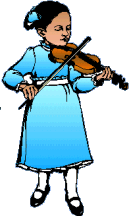 Art
is creation, in the physical realm as well as the spiritual. An important
basic quality, which we adults already find difficult to embrace,
is learned: to participate in everything we encounter in the outside
world, to engage ourselves, and to attempt to create and design it ourselves.
These artistic activities have a special position in our lives,
because we often just automatically perform physical acts (put on
shoes, turn lights on/off, sit down in the subway, etc.). In creativity,
however, it becomes necessary to utilize a full bandwidth of senses
and abilities. Art
is creation, in the physical realm as well as the spiritual. An important
basic quality, which we adults already find difficult to embrace,
is learned: to participate in everything we encounter in the outside
world, to engage ourselves, and to attempt to create and design it ourselves.
These artistic activities have a special position in our lives,
because we often just automatically perform physical acts (put on
shoes, turn lights on/off, sit down in the subway, etc.). In creativity,
however, it becomes necessary to utilize a full bandwidth of senses
and abilities.
When engaged in artistic exercise, one encounters
a somewhat unfamiliar situation where there are no activities based
on routine. Full concentration is certainly necessary, but it spans
a broad index. The immersing oneself in the material (colors,
wood, clay, rhythmic motion, sounds, poetry) presents a problem
we can not solve if we do not dis-solve ourselves into the matter.
This process of immersion often triggers a
scale of emotions: expectation, disappointment, anger, resignation,
reflection, surprise, new hope, new effort, and intense joy about the creative
project.
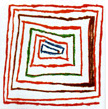 This
participation stays not only on a spiritual plane, but advances deep into
the physical. One character trait of children is their strong
connection of the spiritual and physical. Giving children
the opportunity to express emotions through artistic endeavors means fulfilling
one of their most essential needs. Through these endeavors, they
learn how to approach and challenge a problem with all their soul
and each fiber in their body, a problem which appears significant
not because the solution provides a certain material benefit, but simply
because it is (humanly) interesting. The foundation is built
to cultivate and develop interest. This
participation stays not only on a spiritual plane, but advances deep into
the physical. One character trait of children is their strong
connection of the spiritual and physical. Giving children
the opportunity to express emotions through artistic endeavors means fulfilling
one of their most essential needs. Through these endeavors, they
learn how to approach and challenge a problem with all their soul
and each fiber in their body, a problem which appears significant
not because the solution provides a certain material benefit, but simply
because it is (humanly) interesting. The foundation is built
to cultivate and develop interest.
This is where the circle of the four areas
closes. Essentially the children are offered a broad spectrum
of artistic immersion, which they can utilize as an equalizer to the intellectual
work on the computer. Themes and subjects (music, theater,
painting, etc.) are adjusted and offered according to individual
progress, and 'taught' overlapping ages (even hand writing).
 3.3 Social area: 3.3 Social area:
'Social learning', like already indicated, is incorporated in the
respective other areas, since it can not be considered an isolated
part. Social togetherness is constantly regenerated, and requires
teamwork and conflict- and problem solving throughout the daily events.
Furthermore, the frame of social togetherness is expanded to include
the family and environment.
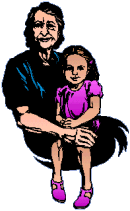 An
essential social process-goal is to raise the children's awareness of being
a part of this community (be it school, family, society/state),
in which every individual is dependent on the other, and where sharing
yields the greatest rewards. The tasks pupils accomplish in
their environment are assisting and independently providing services
to the community they live in. These services can be related to people
and/or animals and/or the environment, and are attended to outside
'regular' school hours. They are a fixed ingredient to the
learning process itself, and thus included in the process-goals.
A portion of this social attention is conducted in groups, and devoted
to 'marginal elements' of society ('antisocials', HIV positives, etc.).
Through active compassion, help is offered where it is needed and wanted.
Various projects should be designed for each group, and include the participation
of the students' parents. An
essential social process-goal is to raise the children's awareness of being
a part of this community (be it school, family, society/state),
in which every individual is dependent on the other, and where sharing
yields the greatest rewards. The tasks pupils accomplish in
their environment are assisting and independently providing services
to the community they live in. These services can be related to people
and/or animals and/or the environment, and are attended to outside
'regular' school hours. They are a fixed ingredient to the
learning process itself, and thus included in the process-goals.
A portion of this social attention is conducted in groups, and devoted
to 'marginal elements' of society ('antisocials', HIV positives, etc.).
Through active compassion, help is offered where it is needed and wanted.
Various projects should be designed for each group, and include the participation
of the students' parents.
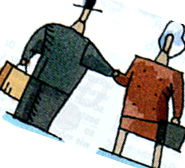 The
parents always play the biggest supporting role in the social learning
process, be it their contribution as a person, through their knowledge
and experience, or through the provision of useful materials and
contacts. In any event, the school community of students/teachers/parents
is an important element that, through constant adjustment to the process's
needs, becomes a productive function of mutual exchange. Considerations
even go as far as suggesting that a truly successful achievement
of all components is only possible when all concerned in the community
contribute their part, and thus also receive a portion of the final
credit. The
parents always play the biggest supporting role in the social learning
process, be it their contribution as a person, through their knowledge
and experience, or through the provision of useful materials and
contacts. In any event, the school community of students/teachers/parents
is an important element that, through constant adjustment to the process's
needs, becomes a productive function of mutual exchange. Considerations
even go as far as suggesting that a truly successful achievement
of all components is only possible when all concerned in the community
contribute their part, and thus also receive a portion of the final
credit.
 3.4 Physical education: 3.4 Physical education:
 Because
every human is a Whole, consisting of body, mind, and soul, training of
the physical body must receive equal priority. Joyous play
and bodily motion balances all sitting and intellectual activities.
Children attend to a social longing for significant creative engagement
with their hunger for movement. Therefore attention should be given
to the joy of bodily movement as opposed to the training of 'high
performance' athletes. The basis and starting point for this
physical education is to participate in a game with each other, dance to
music, or even experience the tranquility of a flowing sequence
of motions in a far eastern discipline. Certainly Because
every human is a Whole, consisting of body, mind, and soul, training of
the physical body must receive equal priority. Joyous play
and bodily motion balances all sitting and intellectual activities.
Children attend to a social longing for significant creative engagement
with their hunger for movement. Therefore attention should be given
to the joy of bodily movement as opposed to the training of 'high
performance' athletes. The basis and starting point for this
physical education is to participate in a game with each other, dance to
music, or even experience the tranquility of a flowing sequence
of motions in a far eastern discipline. Certainly
gymnastics, which provides feedback about
the state of one's body's flexibility and ability to move, are also
part of this repertoire. Outdoor activities are also proposed, where,
away from confined interior spaces, the children can enjoy games
in fresh air and 'freedom'. Basically, students select their
form of physical activity, as long as they do not disturb the community
through rough behavior (danger of injury).
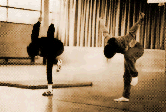 Everyone
may test their physical limits, and will be encouraged in their efforts
to learn any particular discipline. Here too, like in the
musical-creative area, lie possibilities to experience various emotions
(e.g. fear), and learn how to cope with them. In this, the group
shall be of support, but must never exert pressure. The
children may again experience the existence of different character, but
without judgment - such as whether dancing is perhaps less of a
sport than Tai Chi. Because the social component - as desired
by the children themselves - has its place in this area, there are no competitive
games or contests. The emphasis is on well-being and physical
activity, which comprise the foremost element. Everyone
may test their physical limits, and will be encouraged in their efforts
to learn any particular discipline. Here too, like in the
musical-creative area, lie possibilities to experience various emotions
(e.g. fear), and learn how to cope with them. In this, the group
shall be of support, but must never exert pressure. The
children may again experience the existence of different character, but
without judgment - such as whether dancing is perhaps less of a
sport than Tai Chi. Because the social component - as desired
by the children themselves - has its place in this area, there are no competitive
games or contests. The emphasis is on well-being and physical
activity, which comprise the foremost element.
I have the following comments regarding the process:
 The
children select their process-guides, not opposite. It may take some
time for new beginners to find their rhythm, but since advanced
learners are already in the community, they can receive help.
Every child will establish when a change of subjects is needed, and when
this change is to take place. Since the process-guides
are located in various rooms, the changing children are always in a safe
environment. The
children select their process-guides, not opposite. It may take some
time for new beginners to find their rhythm, but since advanced
learners are already in the community, they can receive help.
Every child will establish when a change of subjects is needed, and when
this change is to take place. Since the process-guides
are located in various rooms, the changing children are always in a safe
environment.
'Core-sessions' for different activities are posted on the weekend
for the following two weeks. This is how the children will
know when they may attend a preferred activity. Learning will start
with an 'arrival period' in the morning (between 8 and 9 a.m.), and
provides for a common lunch break between 1 and 2 p.m. 1-2
hours of learning follow in the afternoon, at 4 p.m. the school day
is over.
 The
children keep a learning journal, which they may design to their liking,
where they record their desired activities, achieved process-goals
and social services done outside school. Other assignments
to be attended at home are sent over the Internet to everyone's email address,
or taken home via CD-ROM. Children without a computer at home
have the opportunity to finish their assignments in school or with
the help of their peers (enter a social service credit for the helper). The
children keep a learning journal, which they may design to their liking,
where they record their desired activities, achieved process-goals
and social services done outside school. Other assignments
to be attended at home are sent over the Internet to everyone's email address,
or taken home via CD-ROM. Children without a computer at home
have the opportunity to finish their assignments in school or with
the help of their peers (enter a social service credit for the helper).
Nature experiences, environmental services, and care of marginal
social groups is undertaken afternoons in groups (probably three
afternoons per week). As responsibility increases, the children
may select one or more afternoons themselves. They also may chose
what they want to do, and with whom. If possible, the parents
should be involved. Twice a month, activities,
problems, and achievements will be presented to a school community
forum. The forum will feature a bulletin board for information,
problems, assistance and questions, which can also be announced
via Internet address.
 Furthermore,
two Saturdays per month are off, the others only provide programs
until noon. Since many parents are having difficulties to keep children
sensibly occupied during long holidays, a holiday program should be
designed together, containing various community aspects (also the
opportunity to take over certain services, help out on a farm, etc.).
Perhaps it is possible to arrange for an exchange program with a neighboring
country on the Internet, which would open up a whole new array of prospects.
Under close scrutiny, this new elementary school constellation offers
opportunities to develop unexpected possibilities, not ruling out
anything or anyone. Furthermore,
two Saturdays per month are off, the others only provide programs
until noon. Since many parents are having difficulties to keep children
sensibly occupied during long holidays, a holiday program should be
designed together, containing various community aspects (also the
opportunity to take over certain services, help out on a farm, etc.).
Perhaps it is possible to arrange for an exchange program with a neighboring
country on the Internet, which would open up a whole new array of prospects.
Under close scrutiny, this new elementary school constellation offers
opportunities to develop unexpected possibilities, not ruling out
anything or anyone.
As usual - and this has often happened to me - the children themselves
can probably contribute more useful ideas than even we adults
are able to, with their unspoiled, fresh approach and healthy curiosity.
With certainty, the learning process therefore remains a two way street,
and I am really looking forward to it!
  
|
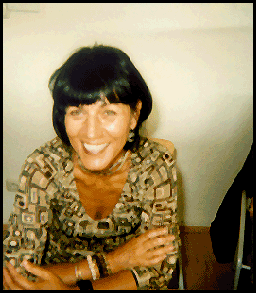 I found the idea for this concept in my own Self - my identity as child,
mother, wife / woman, teacher, manager, and a member of society.
None of these aspects of life can be disregarded, and I am convinced that
all these roles combine to form a Whole, which is the purpose of all our
doing and living.
I found the idea for this concept in my own Self - my identity as child,
mother, wife / woman, teacher, manager, and a member of society.
None of these aspects of life can be disregarded, and I am convinced that
all these roles combine to form a Whole, which is the purpose of all our
doing and living.
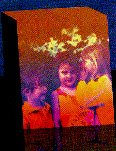 I
directed my efforts towards approaching children by encouraging their interests
and curiosities to facilitate the development of their personalities.
I was, and am, convinced that, the strengthening of self esteem, personal
flexibility, and the ability to acquire knowledge through and with the
adoption of social skills are the most important attributes one should
develop through learning.
I
directed my efforts towards approaching children by encouraging their interests
and curiosities to facilitate the development of their personalities.
I was, and am, convinced that, the strengthening of self esteem, personal
flexibility, and the ability to acquire knowledge through and with the
adoption of social skills are the most important attributes one should
develop through learning.
 my
colleagues, who found themselves befuddled by something they never encountered
in teaching before. Thus, my pupils, their parents and I were branded
as being 'extraneous'. What made me discontinue my practical
application of this concept was my status, receiving the support of the
students, parents, and the headmaster, but not having initiated a dialogue
with the school board to 'officially' receive their blessing, and also
partially the inability to negotiate the frequent confrontations with my
professional surroundings.
my
colleagues, who found themselves befuddled by something they never encountered
in teaching before. Thus, my pupils, their parents and I were branded
as being 'extraneous'. What made me discontinue my practical
application of this concept was my status, receiving the support of the
students, parents, and the headmaster, but not having initiated a dialogue
with the school board to 'officially' receive their blessing, and also
partially the inability to negotiate the frequent confrontations with my
professional surroundings.
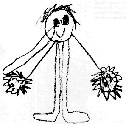 I
want to begin with the children. They are my profession as elementary
school teacher, and perhaps even my life's mission. For me,
children are the most wonderful consequence of human existence, and a great
enrichment of life. They receive my attention and respect in all
of my considerations. I attempt to draw from my own experiences,
ideas and visions, as much as from those of congenial others, because we
are all one community. Thus I hope to find a WHOLE, a mutuality,
which will make it possible to apply this concept, and which will make
it a success.
I
want to begin with the children. They are my profession as elementary
school teacher, and perhaps even my life's mission. For me,
children are the most wonderful consequence of human existence, and a great
enrichment of life. They receive my attention and respect in all
of my considerations. I attempt to draw from my own experiences,
ideas and visions, as much as from those of congenial others, because we
are all one community. Thus I hope to find a WHOLE, a mutuality,
which will make it possible to apply this concept, and which will make
it a success.
 Our
world is changing. The worldwide connectivity boom (Fax, Internet,
E-Mail, video conferencing, etc.) not only accelerates the transmission
of data and knowledge, but creates a flood of information which has become
completely unpredictable. This change certainly affects science and
the economy, but especially and foremost, our society. Previously
well justified and functional systems no longer measure up to these new
demands; more often, linear development forecasts get bogged down in the
more and more encountered insecure and imponderable. This results
in a change of values, which in turn requires people to diversify their
behavior patterns in almost all areas of life. Thus the human image
is changing to an individual who lives as a Whole, and no longer is he
considered a kind of mechanical machine, like in earlier times.
Our
world is changing. The worldwide connectivity boom (Fax, Internet,
E-Mail, video conferencing, etc.) not only accelerates the transmission
of data and knowledge, but creates a flood of information which has become
completely unpredictable. This change certainly affects science and
the economy, but especially and foremost, our society. Previously
well justified and functional systems no longer measure up to these new
demands; more often, linear development forecasts get bogged down in the
more and more encountered insecure and imponderable. This results
in a change of values, which in turn requires people to diversify their
behavior patterns in almost all areas of life. Thus the human image
is changing to an individual who lives as a Whole, and no longer is he
considered a kind of mechanical machine, like in earlier times.
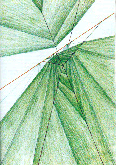 The
priorities are to set open a whole new spectrum of possibilities, a spectrum
which mainly results in greater flexibility and creativity. It becomes
easier to accept the insecure and imponderable caused by the changes, and
one is more readily able to discover alternative problem solving means.
However, if the offered education and training continues to strictly adhere
to our old parameters of upbringing, the necessary bandwidth for diversity
will turn up missing. Flexibility and creativity can only
come through individual personality development in the area of social interaction.
With these skills, one will then be able to acquire any knowledge needed
at any point in time. With the right tools as companions on this
learning journey (computers and internet, etc.), the factual knowledge
will be found independently.
The
priorities are to set open a whole new spectrum of possibilities, a spectrum
which mainly results in greater flexibility and creativity. It becomes
easier to accept the insecure and imponderable caused by the changes, and
one is more readily able to discover alternative problem solving means.
However, if the offered education and training continues to strictly adhere
to our old parameters of upbringing, the necessary bandwidth for diversity
will turn up missing. Flexibility and creativity can only
come through individual personality development in the area of social interaction.
With these skills, one will then be able to acquire any knowledge needed
at any point in time. With the right tools as companions on this
learning journey (computers and internet, etc.), the factual knowledge
will be found independently.
 To
measure up to these demands, the inflexible educational system must be
urgently changed. The most pressing goal is to dissolve the rigid
hierarchies, and convert them into a form of participation that becomes
the basis for the desired and necessary interaction. In school, this
means dissolving rigid restrictions, such as age groups, classes and schedules.
The 'syllabus' includes process-goals divided into intellectual, social,
musical-creative, and physical areas. If necessary, these process-goals
can be constantly adjusted and redefined as required by current events
and the needs of life. The teachers are process-guides for the students,
and vice versa.
To
measure up to these demands, the inflexible educational system must be
urgently changed. The most pressing goal is to dissolve the rigid
hierarchies, and convert them into a form of participation that becomes
the basis for the desired and necessary interaction. In school, this
means dissolving rigid restrictions, such as age groups, classes and schedules.
The 'syllabus' includes process-goals divided into intellectual, social,
musical-creative, and physical areas. If necessary, these process-goals
can be constantly adjusted and redefined as required by current events
and the needs of life. The teachers are process-guides for the students,
and vice versa.
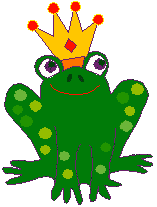 is
maintained, and thus evolves the foundation for sound self esteem, which
in turn mobilizes creativity and flexibility. One who possesses these
qualities will react to changes not with passiveness, fear, or denial,
but instead adapt to the new situation, and become a productive contributor.
Then the children will exhibit the vivacity to develop their most wonderful
god given qualities - to pursue their curiosities, the desire to discover
the new, to experiment and invent, to investigate, to experience and to
understand the world and life itself.
is
maintained, and thus evolves the foundation for sound self esteem, which
in turn mobilizes creativity and flexibility. One who possesses these
qualities will react to changes not with passiveness, fear, or denial,
but instead adapt to the new situation, and become a productive contributor.
Then the children will exhibit the vivacity to develop their most wonderful
god given qualities - to pursue their curiosities, the desire to discover
the new, to experiment and invent, to investigate, to experience and to
understand the world and life itself.
 The
concept includes a general introduction, as well as:
The
concept includes a general introduction, as well as:
 Although
each child, dependent on their respective age, possesses approximately
similar degrees of physical development, their degrees of intellectual,
creative, or even social development may differ significantly.
Individual talents, whether genetically passed down, acquired from
the social environment, or parentally encouraged, become important factors
which can be supported and developed through process-guided learning.
What all children have in common, though, is their curiosity and the urge
to discover and try the new. This curiosity remains the basic
motivation for wanting to learn, to discover, invent, understand, and to
experience practical life and find a place in society.
Although
each child, dependent on their respective age, possesses approximately
similar degrees of physical development, their degrees of intellectual,
creative, or even social development may differ significantly.
Individual talents, whether genetically passed down, acquired from
the social environment, or parentally encouraged, become important factors
which can be supported and developed through process-guided learning.
What all children have in common, though, is their curiosity and the urge
to discover and try the new. This curiosity remains the basic
motivation for wanting to learn, to discover, invent, understand, and to
experience practical life and find a place in society.
 Which
are the basic skills children learn in elementary school? On
one hand, the classic cultural techniques, such as writing, reading, and
basic math, on the other, fundamental knowledge that allows them
to discover and understand their world, such as biology, geography,
history, etc. As mentioned before, children begin school with
certain suppositions. In order not to suffocate their interest
and curiosity, and to offer them a playful and simple intercourse with
the innovative, knowledge acquisition is arranged via the computer.
Through the use of instructional programs especially geared for
access by children, students can satisfy their exploring spirits by
clicking through the respective subject areas. They will
solve tasks in a playful manner through their curiosity and thirst
to discover. If a student is at first unable to complete a
task, the program will offer additional help, keeping frustration
to a minimum. In any event, the pupils will solve tasks either
independently, or through the help of the group and integrated older
students, which can be asked for help anytime.
Which
are the basic skills children learn in elementary school? On
one hand, the classic cultural techniques, such as writing, reading, and
basic math, on the other, fundamental knowledge that allows them
to discover and understand their world, such as biology, geography,
history, etc. As mentioned before, children begin school with
certain suppositions. In order not to suffocate their interest
and curiosity, and to offer them a playful and simple intercourse with
the innovative, knowledge acquisition is arranged via the computer.
Through the use of instructional programs especially geared for
access by children, students can satisfy their exploring spirits by
clicking through the respective subject areas. They will
solve tasks in a playful manner through their curiosity and thirst
to discover. If a student is at first unable to complete a
task, the program will offer additional help, keeping frustration
to a minimum. In any event, the pupils will solve tasks either
independently, or through the help of the group and integrated older
students, which can be asked for help anytime.
 This
way even writing and reading are learned via computer programs. This
eliminates the burden of simultaneously learning content as well
as the physical process of writing itself (how do I write legibly
and spell correctly), which is a problem for many children. My concept
instead plans a reorientation: writing will be practiced on the
computer, while learning hand writing skills is transferred into
the musical-creative area, where it can be rehearsed with the appropriate
muse and artistry. The same goes for reading, which is not only
learned on the computer.
This
way even writing and reading are learned via computer programs. This
eliminates the burden of simultaneously learning content as well
as the physical process of writing itself (how do I write legibly
and spell correctly), which is a problem for many children. My concept
instead plans a reorientation: writing will be practiced on the
computer, while learning hand writing skills is transferred into
the musical-creative area, where it can be rehearsed with the appropriate
muse and artistry. The same goes for reading, which is not only
learned on the computer.
 Art
is creation, in the physical realm as well as the spiritual. An important
basic quality, which we adults already find difficult to embrace,
is learned: to participate in everything we encounter in the outside
world, to engage ourselves, and to attempt to create and design it ourselves.
These artistic activities have a special position in our lives,
because we often just automatically perform physical acts (put on
shoes, turn lights on/off, sit down in the subway, etc.). In creativity,
however, it becomes necessary to utilize a full bandwidth of senses
and abilities.
Art
is creation, in the physical realm as well as the spiritual. An important
basic quality, which we adults already find difficult to embrace,
is learned: to participate in everything we encounter in the outside
world, to engage ourselves, and to attempt to create and design it ourselves.
These artistic activities have a special position in our lives,
because we often just automatically perform physical acts (put on
shoes, turn lights on/off, sit down in the subway, etc.). In creativity,
however, it becomes necessary to utilize a full bandwidth of senses
and abilities.
 This
participation stays not only on a spiritual plane, but advances deep into
the physical. One character trait of children is their strong
connection of the spiritual and physical. Giving children
the opportunity to express emotions through artistic endeavors means fulfilling
one of their most essential needs. Through these endeavors, they
learn how to approach and challenge a problem with all their soul
and each fiber in their body, a problem which appears significant
not because the solution provides a certain material benefit, but simply
because it is (humanly) interesting. The foundation is built
to cultivate and develop interest.
This
participation stays not only on a spiritual plane, but advances deep into
the physical. One character trait of children is their strong
connection of the spiritual and physical. Giving children
the opportunity to express emotions through artistic endeavors means fulfilling
one of their most essential needs. Through these endeavors, they
learn how to approach and challenge a problem with all their soul
and each fiber in their body, a problem which appears significant
not because the solution provides a certain material benefit, but simply
because it is (humanly) interesting. The foundation is built
to cultivate and develop interest.
 An
essential social process-goal is to raise the children's awareness of being
a part of this community (be it school, family, society/state),
in which every individual is dependent on the other, and where sharing
yields the greatest rewards. The tasks pupils accomplish in
their environment are assisting and independently providing services
to the community they live in. These services can be related to people
and/or animals and/or the environment, and are attended to outside
'regular' school hours. They are a fixed ingredient to the
learning process itself, and thus included in the process-goals.
A portion of this social attention is conducted in groups, and devoted
to 'marginal elements' of society ('antisocials', HIV positives, etc.).
Through active compassion, help is offered where it is needed and wanted.
Various projects should be designed for each group, and include the participation
of the students' parents.
An
essential social process-goal is to raise the children's awareness of being
a part of this community (be it school, family, society/state),
in which every individual is dependent on the other, and where sharing
yields the greatest rewards. The tasks pupils accomplish in
their environment are assisting and independently providing services
to the community they live in. These services can be related to people
and/or animals and/or the environment, and are attended to outside
'regular' school hours. They are a fixed ingredient to the
learning process itself, and thus included in the process-goals.
A portion of this social attention is conducted in groups, and devoted
to 'marginal elements' of society ('antisocials', HIV positives, etc.).
Through active compassion, help is offered where it is needed and wanted.
Various projects should be designed for each group, and include the participation
of the students' parents.
 The
parents always play the biggest supporting role in the social learning
process, be it their contribution as a person, through their knowledge
and experience, or through the provision of useful materials and
contacts. In any event, the school community of students/teachers/parents
is an important element that, through constant adjustment to the process's
needs, becomes a productive function of mutual exchange. Considerations
even go as far as suggesting that a truly successful achievement
of all components is only possible when all concerned in the community
contribute their part, and thus also receive a portion of the final
credit.
The
parents always play the biggest supporting role in the social learning
process, be it their contribution as a person, through their knowledge
and experience, or through the provision of useful materials and
contacts. In any event, the school community of students/teachers/parents
is an important element that, through constant adjustment to the process's
needs, becomes a productive function of mutual exchange. Considerations
even go as far as suggesting that a truly successful achievement
of all components is only possible when all concerned in the community
contribute their part, and thus also receive a portion of the final
credit.
 Because
every human is a Whole, consisting of body, mind, and soul, training of
the physical body must receive equal priority. Joyous play
and bodily motion balances all sitting and intellectual activities.
Children attend to a social longing for significant creative engagement
with their hunger for movement. Therefore attention should be given
to the joy of bodily movement as opposed to the training of 'high
performance' athletes. The basis and starting point for this
physical education is to participate in a game with each other, dance to
music, or even experience the tranquility of a flowing sequence
of motions in a far eastern discipline. Certainly
Because
every human is a Whole, consisting of body, mind, and soul, training of
the physical body must receive equal priority. Joyous play
and bodily motion balances all sitting and intellectual activities.
Children attend to a social longing for significant creative engagement
with their hunger for movement. Therefore attention should be given
to the joy of bodily movement as opposed to the training of 'high
performance' athletes. The basis and starting point for this
physical education is to participate in a game with each other, dance to
music, or even experience the tranquility of a flowing sequence
of motions in a far eastern discipline. Certainly
 Everyone
may test their physical limits, and will be encouraged in their efforts
to learn any particular discipline. Here too, like in the
musical-creative area, lie possibilities to experience various emotions
(e.g. fear), and learn how to cope with them. In this, the group
shall be of support, but must never exert pressure. The
children may again experience the existence of different character, but
without judgment - such as whether dancing is perhaps less of a
sport than Tai Chi. Because the social component - as desired
by the children themselves - has its place in this area, there are no competitive
games or contests. The emphasis is on well-being and physical
activity, which comprise the foremost element.
Everyone
may test their physical limits, and will be encouraged in their efforts
to learn any particular discipline. Here too, like in the
musical-creative area, lie possibilities to experience various emotions
(e.g. fear), and learn how to cope with them. In this, the group
shall be of support, but must never exert pressure. The
children may again experience the existence of different character, but
without judgment - such as whether dancing is perhaps less of a
sport than Tai Chi. Because the social component - as desired
by the children themselves - has its place in this area, there are no competitive
games or contests. The emphasis is on well-being and physical
activity, which comprise the foremost element.
 The
children select their process-guides, not opposite. It may take some
time for new beginners to find their rhythm, but since advanced
learners are already in the community, they can receive help.
Every child will establish when a change of subjects is needed, and when
this change is to take place. Since the process-guides
are located in various rooms, the changing children are always in a safe
environment.
The
children select their process-guides, not opposite. It may take some
time for new beginners to find their rhythm, but since advanced
learners are already in the community, they can receive help.
Every child will establish when a change of subjects is needed, and when
this change is to take place. Since the process-guides
are located in various rooms, the changing children are always in a safe
environment.
 The
children keep a learning journal, which they may design to their liking,
where they record their desired activities, achieved process-goals
and social services done outside school. Other assignments
to be attended at home are sent over the Internet to everyone's email address,
or taken home via CD-ROM. Children without a computer at home
have the opportunity to finish their assignments in school or with
the help of their peers (enter a social service credit for the helper).
The
children keep a learning journal, which they may design to their liking,
where they record their desired activities, achieved process-goals
and social services done outside school. Other assignments
to be attended at home are sent over the Internet to everyone's email address,
or taken home via CD-ROM. Children without a computer at home
have the opportunity to finish their assignments in school or with
the help of their peers (enter a social service credit for the helper).
 Furthermore,
two Saturdays per month are off, the others only provide programs
until noon. Since many parents are having difficulties to keep children
sensibly occupied during long holidays, a holiday program should be
designed together, containing various community aspects (also the
opportunity to take over certain services, help out on a farm, etc.).
Perhaps it is possible to arrange for an exchange program with a neighboring
country on the Internet, which would open up a whole new array of prospects.
Under close scrutiny, this new elementary school constellation offers
opportunities to develop unexpected possibilities, not ruling out
anything or anyone.
Furthermore,
two Saturdays per month are off, the others only provide programs
until noon. Since many parents are having difficulties to keep children
sensibly occupied during long holidays, a holiday program should be
designed together, containing various community aspects (also the
opportunity to take over certain services, help out on a farm, etc.).
Perhaps it is possible to arrange for an exchange program with a neighboring
country on the Internet, which would open up a whole new array of prospects.
Under close scrutiny, this new elementary school constellation offers
opportunities to develop unexpected possibilities, not ruling out
anything or anyone.